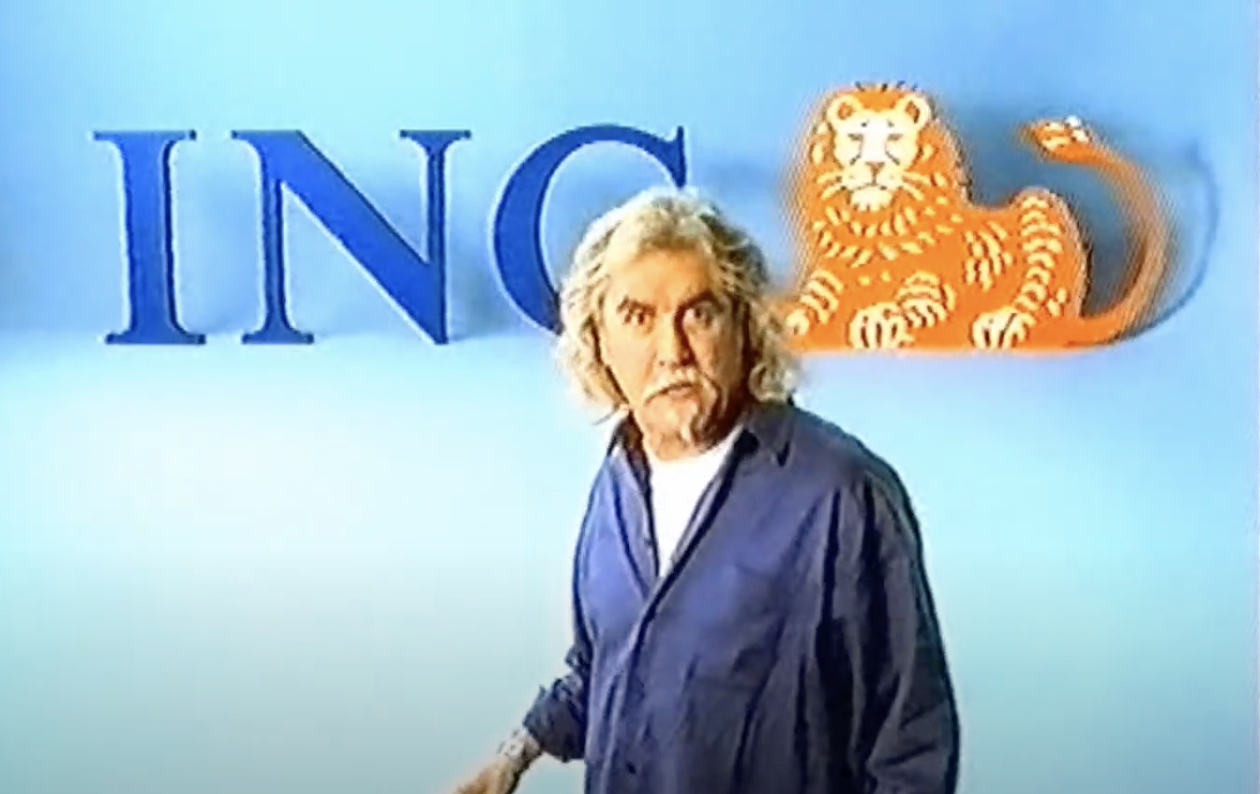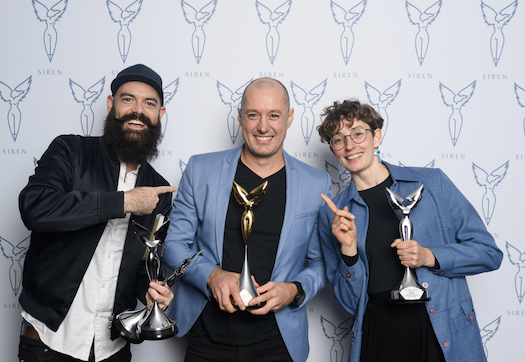Comment from Peter Saxon
This year’s Gold Sirens winner, Lilydale/Steggles turkeys, is a ripper of an ad that couldn’t be bothered ticking any boxes. Instead, it cheats at noughts and crosses… and wins with an ad called Ugly but Good for You – German Jog Techno.
Each year, The Sirens showcase the best ads on radio. And each year, we ask ourselves, why can’t more ads sound this good?
The answer has to do with risk.
Really great creative, the truly memorable kind, the engaging kind that sells products and wins awards, invariably breaks new ground and pushes envelopes.
The first major risk is that the client won’t approve it. Somewhere in the collective conscience of creative teams worldwide is a massive graveyard of brilliant radio ads that have never aired because they fell at the first hurdle. In their stead, we were dished up a relatively safe, compromised 30 secs of airtime (and your time) that’s plain boring. Such ads are often loved by the client but fail to inspire the consumers they were meant to reach.
You don’t give a stuff do you? Billy Conolly for ING

The best example of client-led creative – the one that was a lightbulb moment for me – occurred circa 2002 when Australian financial institutions, then known as building societies, were converting to banks and had to change their brand names accordingly.
One of the first building societies to change their name had a TVC that featured a marching band, skywriters and an enthusiastic crowd of on-lookers cheering them on. (Don’t ask me to name the institution, because I can’t remember the brands involved – which gives you an idea of how effective their campaign was.)
Finally, the camera settles on a little girl as she asks her dad what all the fuss is about. Dad tells her that it’s a big celebration for finance company “ABC” changing its name to finance company “XYZ”.
Upon hearing this revelation, the joy on that kid’s face was as if daddy had furnished proof-positive that Santa Claus does indeed, exist and the elves had awarded her first prize as the world’s best little girl of the year.
I’m sure that the board of XYZ or ABC, or whatever, thought that that ad, the one that they had personally approved, was fantastic… reflective of their institution’s long, proud history and family values. Trouble was that a large chunk of the consumers they wanted to reach wanted to puke every time this tribute to corporate self-indulgence came on the box.
Soon, another finance company (let’s call it DEF) produces a TVC that tackles the name change from DEF to ING in a totally different way.
Note: Whilst there are a few examples on YouTube of clips from ING’s extended campaign, I could not find the all-important original one, which I’ll have to describe to you below. Forgive me.
The scene minimalist – a ladder and two workmen are taking down the DEF sign and from a plain wall, replacing it with ING. Suddenly, Billy Conolly’s face fills the screen as he speaks direct to camera. He says with feyned enthusiasm (words to the effect) ‘Big thing happening here. DEF is changing its name to ING.’ (pregnant pause) ‘You don’t give a stuff, do you?’
It’s the perfect example of, “It’s funny because it’s true.” Upon hearing this truth about adverting in an advertisement, I think I laughed for a week – which was difficult given that the ad came on at least three times a night. More importantly, the ING brand stuck fast in consumer’s minds and is still one the banking sector’s leading brands 20 years later.
To be fair, the client takes the greatest risk. What if the ad bombs? Recall barely registers? We blow 1.5 million. And I’m held to blame?
Usually, the client’s point of contact, say, a brand manager, understands the value of great creative better than most in their company but they still have to sell it to their GM, CEO – or worse, the board of directors, who are generally there to run a steady ship, not take risks with something like German Jog Techno.
When we were at the Sirens finals last week where the M&C Saatchi writing team, Jason Leigh & Melissa Hawkett cleaned up with Ugly but Good for You for Steggles turkeys, we caught up with Steggles Snr. Brand Manager, Shawn Stevens, who said the brief was, “to have a bit of fun and get people to notice turkey. We needed people to be aware of it, before they can buy it.”
How did the Steggles people react to the ad when the M&C creative team first played the demo? “We thought they were nuts,” says Stevens.
Having got past management, there’s usually another major hoop to jump through before the ad can proceed to full production.
“Every company has a legal department that’s willing to throw out all the good stuff,” says Stevens, “But when we were able to show them what we’re trying to do and they understood what the goal was, I think everyone was behind the work.”
Although Stevens insists that the key focus of the campaign was to drive top of mind awareness for the brand, there was a six percent uplift in turkey sales in the month after the campaign.
“The creators were able to do a job perfectly where they took the creative challenge and found the right moment to do it with the right media. It’s a brilliant piece of work. We’re very proud of what the guys were able to accomplish,” says Shawn Stevens.

Peter Saxon
Subscribe to the radioinfo podcast on these platforms: Acast, Apple iTunes Podcasts, Podtail, Spotify, Google Podcasts, TuneIn, or wherever you get your podcasts.




According to the Siren Awards page, "...The Siren Awards promote and reward the commercials that stand out from the crowd, and the winner from each round becomes the judge for the next round. The Siren Awards are designed to attract the best radio creative in Australia....", reference http://www.sirenawards.com.au/about .
The advertisement has a typical classic structure of a message sticking into the mind of the consumer by repetition of the theme, that the product is "ugly, but good for you", then towards the end repetition "Steggles turkeys are good for you". The brand name is associated with goodness repeatedly.
Overall, it is an amusing advertisement and may well generate sales.
At same time, should we consider whether heavy campaigns and whether one advertisement would fit into all kinds of formats?
First if the advertisement is repeated constantly, would the campaign be detrimental.
Second, the one size fits all approach to campaigns may not work when the background music is not suitable for the particular format, ref: https://radioinfo.com.au/news/could-be-radio-self-sabotage . In this article the author remarked that the background music in advertising clashed with the format of the station ("Buddha" on DAB+).
The Steggles campaign may well be suitable for Nova 96.9 or The Edge (96.1) , but not Smooth or "Classic Hits 2CH".
Then consideration must be made of whether the advertisement may induce listener fatigue and backfire against the advertised product.
It may well be that science can determine whether the campaign is effective in measuring the effectiveness of an advertisement.
References:
https://radioinfo.com.au/news/arn%E2%80%99s-neuro-lab-release-sound-you-can-see
https://www.radiotoday.com.au/arn-neuro-lab/
https://mumbrella.com.au/arns-neuro-lab-investigates-power-of-radio-engagement-for-advertisers-677037
Ultimately the "proof in the pudding" is whether the vendor's sales are are increased as a result of the campaign, whether the campaign is not suitable for the format or repeated constantly.
At the same time, for listeners to a particular station, will the constant campaign be a turn off resulting in fewer listeners?
Thank you,
Anthony of exciting, dynamic and analytical Belfield